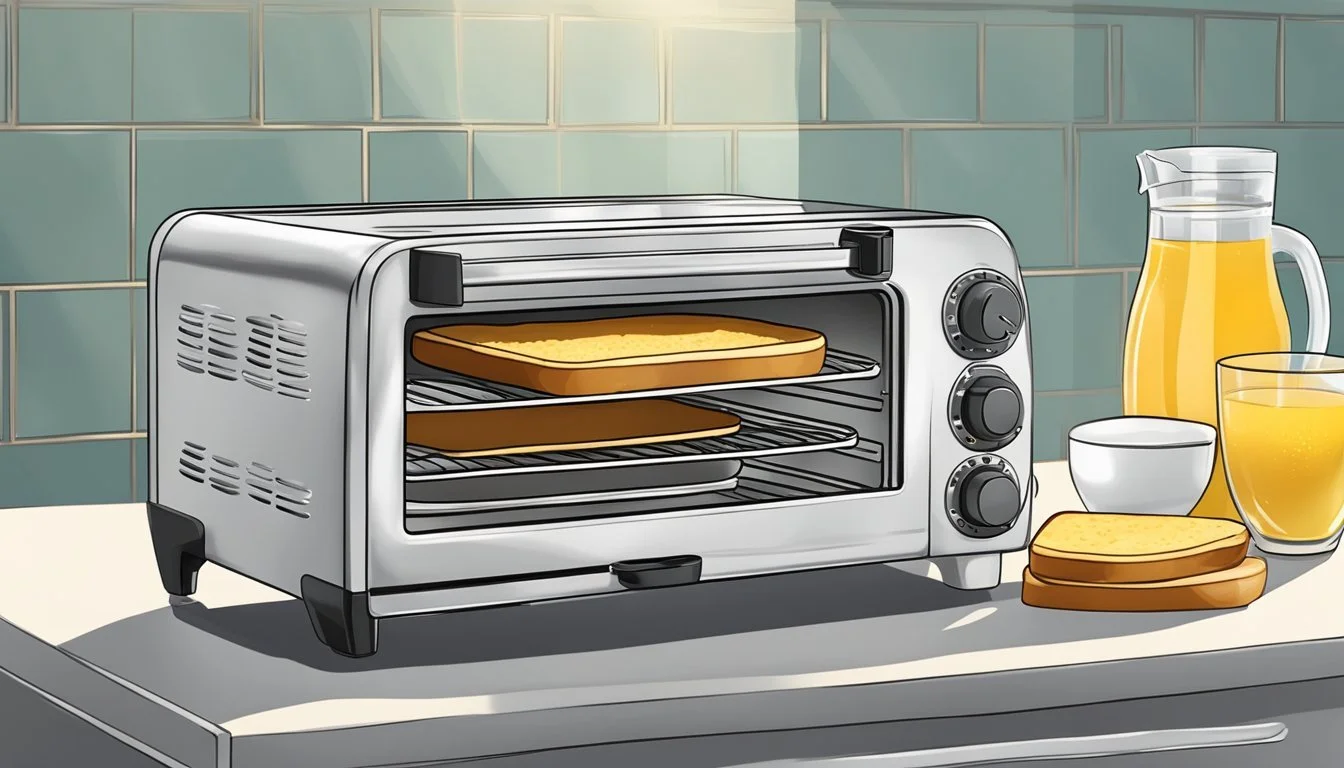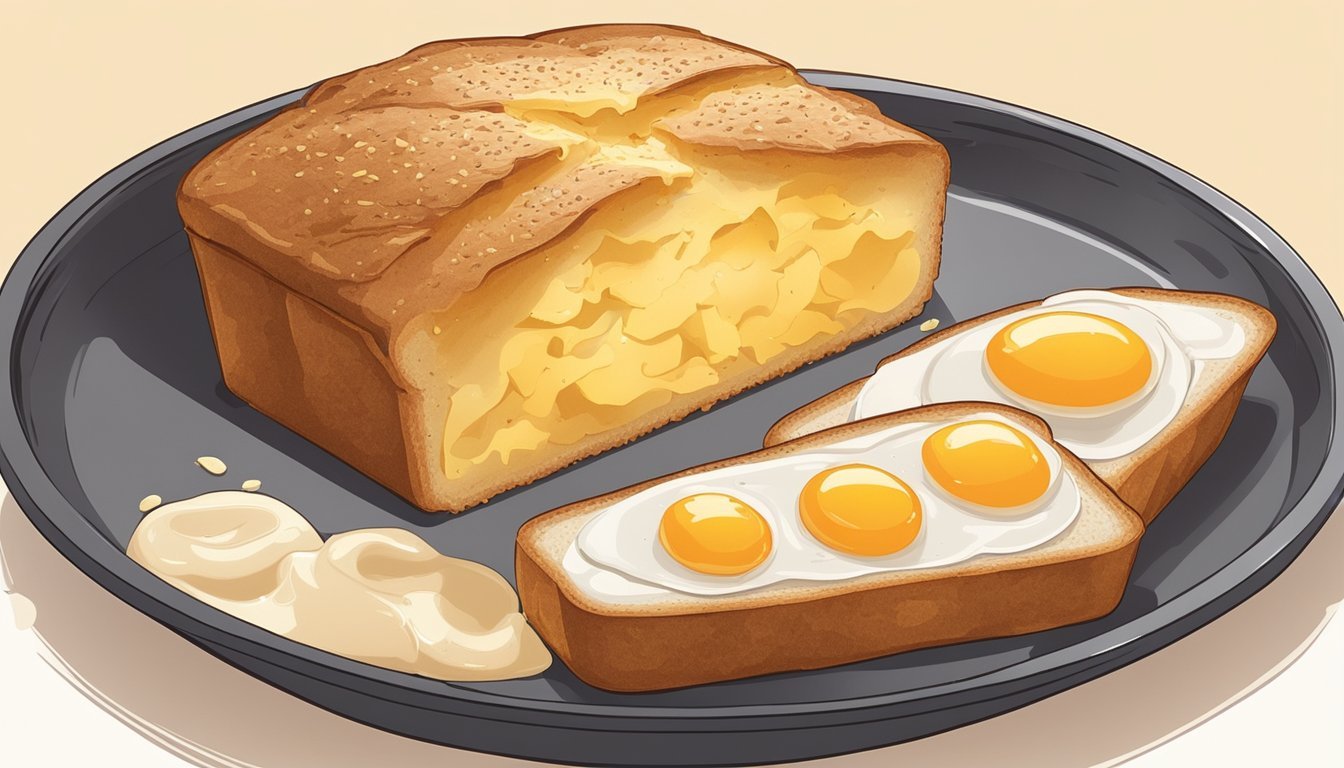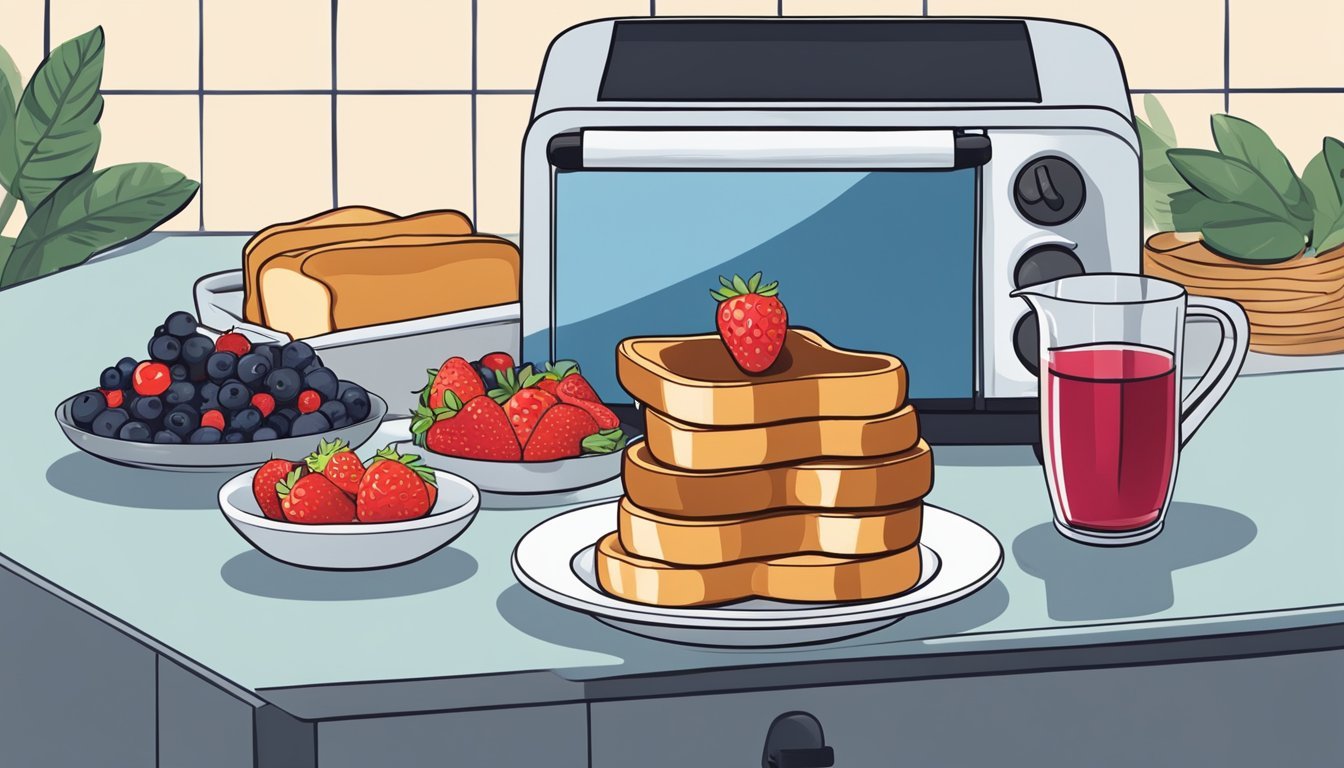How to Reheat Gluten-Free French Toast
Easy and Effective Methods
Reheating gluten-free French toast can be a game-changer for those seeking a quick, delicious breakfast without compromising on texture and flavor. To ensure your reheated French toast remains just as delectable as when it was freshly made, follow a few simple steps. Whether you're a coeliac or simply enjoying a gluten-free diet, this method is perfect for bringing your breakfast back to life.
Start by preheating your oven to 400 degrees Fahrenheit. Arrange your French toast slices in a single layer on a greased baking sheet, ensuring there is space between each piece. Reheat the slices for about 6 to 8 minutes, flipping them halfway through to achieve an even warmth.
Another effective method is using a skillet on medium heat. Simply place your French toast in the skillet, cook each side for around 2-3 minutes, and enjoy a crispy, revitalized breakfast. With these straightforward techniques, your gluten-free French toast will be just as satisfying the second time around.
Understanding Gluten-Free French Toast
Gluten-free French toast is a breakfast favorite made using gluten-free bread. This is essential for individuals with celiac disease or those who follow a gluten-free diet.
The key ingredients for gluten-free French toast include:
Eggs
Milk (or dairy-free options like almond milk or coconut milk)
Cinnamon
Vanilla extract
Salt
Preparing the batter involves whisking together the eggs, milk, cinnamon, vanilla extract, and salt in a shallow dish.
List of Ingredients
Gluten-free bread: Essential for those avoiding gluten.
Eggs: Provide structure and flavor.
Milk: Can be dairy or non-dairy.
Cinnamon & Vanilla Extract: Add warmth and flavor.
Salt: Enhances all the flavors.
The gluten-free bread is dipped into the batter, ensuring each slice is thoroughly coated. This step is crucial, as it allows the bread to soak up the mixture's flavors.
Once the bread is coated, it is cooked on a greased skillet or griddle over medium heat. Melted butter or a dairy-free alternative like olive oil can be used for greasing.
Cooking the toast requires attention to prevent overcooking. Each side is cooked until golden brown, resulting in a perfectly crispy and flavorful French toast.
Gluten-free French toast can be served with maple syrup, fresh fruits, or any preferred toppings, making it a versatile and delicious breakfast option for all.
Essential Ingredients and Substitutes
The quality of your gluten-free French toast highly depends on the choice of ingredients. It's important to choose the right bread, consider dairy-free alternatives, and add sweeteners and flavor enhancements that cater to your personal taste and dietary preferences.
Selecting the Right Bread
Gluten-free bread is the foundation of gluten-free French toast. Look for bread that is sturdy enough to hold up when dipped in the egg mixture. Breads made from ingredients like rice flour, almond flour, or other gluten-free grains are suitable options.
Avoid overly crumbly or soft breads as they may disintegrate during cooking. Some brands offer gluten-free bread specifically designed for durability in recipes like French toast.
Dairy-Free Alternatives
For those who need to avoid dairy, almond milk and coconut milk are excellent substitutes for regular milk. Almond milk provides a subtle nutty flavor, while coconut milk adds a richer, creamier texture.
Olive oil or dairy-free butter can replace regular butter when cooking. These options ensure that the French toast remains rich and flavorful without compromising dietary restrictions.
Sweeteners and Flavor Enhancements
Incorporating ingredients like sugar, vanilla, and cinnamon enhances the taste of gluten-free French toast.
Cinnamon and vanilla extract are classic additions. For sweetness, you can use granulated sugar or honey. For a healthier option, maple syrup or agave nectar are good alternatives.
Adding a touch of nutmeg can also provide a warm, spicy note that compliments the other flavors.
These thoughtful ingredient choices ensure that your gluten-free French toast is both delicious and suitable for a variety of dietary needs.
Step-by-Step French Toast Preparation
A perfectly cooked gluten-free French toast requires attention to the batter, frying technique, and alternative cooking methods.
Creating the Perfect Batter
To start, gather eggs, unsweetened almond milk (or any milk of your choice), sugar, ground cinnamon, and vanilla extract.
In a large bowl, whisk together the eggs until they are well-beaten. Add almond milk, sugar, a pinch of salt, and cinnamon. The consistency should be smooth and well-integrated.
For a touch of flavor, include vanilla extract and, if desired, a bit of nutmeg or maple syrup. Gluten-free bread, such as brioche or regular slices, should be ready for dipping.
The batter should coat the bread evenly without being too runny or thick.
Golden Brown Frying Techniques
Preheat a non-stick skillet over medium heat and melt a tablespoon of butter or oil in the pan.
While the pan heats, dip each slice of gluten-free bread into the batter, ensuring both sides are well-coated but not soaking wet. This helps achieve an even golden brown color.
Place the coated bread in the skillet. Cook each side for about 2-3 minutes or until golden brown. For best results, use a rubber spatula to flip the bread, ensuring it doesn’t break apart.
Adjust your heat as necessary to prevent burning or undercooking.
Alternative Cooking Options
Consider other methods if you prefer a different texture or have dietary restrictions.
Oven-baking offers a uniform crispiness. Preheat the oven to 350°F (175°C) and place the battered bread on a parchment-lined baking sheet. Bake for 10-15 minutes, flipping halfway through.
For air frying, coat the bread as usual and lay them in a single layer in the air fryer basket. Cook at 375°F (190°C) for 8 minutes, flipping midway.
Experiment with a combination of methods if desired. Reheat any leftovers using these same techniques to retain texture and flavor.
Storing and Freezing Instructions
Properly storing and freezing gluten-free French toast ensures it stays fresh and retains its delicious flavor. Here’s how you can keep your leftovers or prepare for future meals with these specific methods.
Storing Leftover French Toast
To store leftover gluten-free French toast, allow it to cool completely at room temperature. Once cooled, place the slices in an airtight container or wrap them tightly with plastic wrap or aluminum foil to prevent moisture loss and freezer burn.
Leftovers can be stored in the refrigerator for up to 3-4 days. When ready to reheat, preheat your oven to 375°F, arrange the slices on a baking sheet, and warm them for 8-10 minutes, flipping halfway through.
Freezing for Long-Term Freshness
For longer storage, freezing gluten-free French toast is highly effective. Begin by letting the French toast slices cool completely. Next, lay the slices on a baking sheet in a single layer and flash freeze them for about 1-2 hours until they are firm to prevent clumping.
After freezing, transfer the slices to an airtight container or a resealable plastic freezer bag, ensuring all air is removed to avoid freezer burn. Label with the date and store for up to 2 months. When you’re ready to enjoy, reheat in an oven at 375°F for 8-10 minutes or pop them directly into the toaster for a quick and crispy result.
Mastering the Reheating Process
Reviving gluten-free French toast to its optimal warmth and texture requires specific reheating techniques. Each method has its unique advantages, ensuring evenly heated, crispy results.
Oven Reheating for Even Warmth
Oven reheating is ideal for maintaining the integrity of gluten-free French toast. Start by preheating the oven to 350°F (180°C). Place slices in a single layer on a greased baking sheet, ensuring they don't overlap to allow even warming.
Cover the sheet with aluminum foil to prevent the toast from drying out. Heat for 8-10 minutes, flipping the slices mid-way. To add crispiness, remove the foil for the last 2 minutes. This method keeps the toast warm throughout while delivering a slightly crisp exterior.
On-the-Spot Toaster Reheating
For a quick fix, the toaster is a great option. Insert slices into the toaster slots, ensuring they're not too thick. Set the toaster to a medium setting to achieve a nice balance between warmth and crispiness.
Avoid using the highest setting to prevent burning. This method is perfect for those needing a fast, on-the-spot reheat. Just remember, toaster reheating might not warm the toast as uniformly as the oven method, but it provides a satisfyingly crispy result.
Microwave Reheating Tips
When in a hurry, the microwave offers speed and convenience. Place the French toast slices on a microwave-safe plate. To avoid sogginess, place a slightly damp paper towel over the slices. Microwave on high for 30 seconds to 1 minute, checking frequently to prevent overheating.
Notably, microwaving won't give you crispy edges, but it does ensure the toast is adequately warmed. If you desire some crispiness post-microwaving, a quick stint in the toaster can help achieve that texture.
By following these methods, anyone can enjoy perfectly reheated gluten-free French toast, whether it be from the oven, toaster, or microwave.
Serving Suggestions and Toppings
When reheating gluten-free French toast, consider pairing it with a variety of classic and innovative toppings to enhance its flavor. These suggestions can turn a simple breakfast into a special treat for yourself or a crowd.
Classic Toppings and their Pairings
For a traditional and delightful experience, maple syrup is an excellent choice. Drizzle pure maple syrup over the warm toast to amplify its sweetness.
Powdered sugar can also be sprinkled on top for a subtle touch of sweetness, adding both flavor and an appealing appearance.
Fresh fruit like fresh berries such as strawberries, blueberries, and raspberries add a refreshing contrast. Pair these with a dollop of whipped cream for an indulgent finish.
Other classic toppings include honey and butter, which melt beautifully into the toast, enhancing its rich texture.
Innovative Serving Ideas for Entertaining
For a special brunch or a crowd, consider serving gluten-free French toast in more creative ways. Stuffed French toast with cream cheese and fresh berries can elevate the dish to a gourmet level.
Top the toast with homemade fruit compote or sautéed apples spiced with cinnamon for a cozy, warm flavor.
Savory toppings like bacon and avocado create a unique, balanced dish that is both satisfying and unexpected.
Additionally, nut butters such as almond or peanut butter add a delightful protein boost and rich flavor.
For entertaining, serve French toast bites on skewers with different toppings to create a fun and interactive food station.
By experimenting with these ideas, reheated gluten-free French toast can be both delicious and memorable.
Nutritional Information and Dietary Considerations
When reheating gluten-free French toast, it's essential to consider its nutritional aspects and dietary requirements.
Calories: The calorie count can vary depending on the ingredients. On average, one slice of gluten-free French toast may contain around 150-200 calories. Selecting lower-calorie toppings can help manage caloric intake.
Gluten-Free: Ensuring that all ingredients are gluten-free is crucial for those with celiac disease or gluten sensitivity. Choose certified gluten-free bread and verify that other components, such as spices and vanilla extract, are also gluten-free.
Dairy-Free Option: For those avoiding dairy, use plant-based milk such as almond or soy, and dairy-free butter or oil for cooking.
Saturated Fat: Monitor the use of butter to keep saturated fat levels in check. Alternatives like olive oil can be used to reduce saturated fat content.
Carbohydrates: The carbohydrate content is primarily from the bread. A slice typically contains about 20-30 grams of carbohydrates. Using whole-grain or fiber-rich gluten-free bread can help improve fiber intake.
Fiber: Gluten-free bread often lacks fiber. Supplemental fiber, such as fruits or seeds added as toppings, can increase fiber intake.
Protein: Eggs provide protein, with each slice containing around 4-6 grams of protein. For a vegan option, egg substitutes like flaxseed or chia seed mixtures can be used to maintain protein content.
Vegan: For vegan French toast, substitute eggs with a mixture of flaxseed or chia seeds and water, and use plant-based milk and cooking oils.
Cholesterol: Eggs contribute to cholesterol levels. Reducing the number of eggs or using egg substitutes can help manage cholesterol intake.
Sodium: Monitor added salt and use low-sodium ingredients when possible to keep sodium levels low.
Gluten-Free French Toast Variations
There are numerous ways to enhance gluten-free French toast. Each variation caters to different dietary preferences and adds a unique flavor.
Banana French Toast
Sliced bananas sautéed in a bit of butter make an excellent topping. They add a natural sweetness and creamy texture.
Nutty Delight
Top your French toast with chopped nuts like almonds, walnuts, or pecans. For added crunch, lightly toast the nuts before sprinkling them over the French toast.
Gluten-Free Pancake French Toast
For a twist, use gluten-free pancakes instead of bread. This variation combines the fluffiness of pancakes with the rich flavor of French toast.
Paleo Version
For a paleo-friendly option, use a base made from almond or coconut flour bread. Sweeten the egg mixture with a touch of honey or maple syrup.
Vegan French Toast
Substitute eggs with a mixture of ground flaxseed and water. Use your favorite plant-based milk and gluten-free bread.
Homemade Bread
Homemade gluten-free bread can elevate your French toast experience. Freshly baked bread often has a better texture and flavor compared to store-bought options.
Tips for the Perfect Gluten-Free French Toast
For the best gluten-free French toast, start by using quality gluten-free bread. Choose a bread that holds up well to soaking and frying, avoiding those that are too soft or crumbly.
To make the batter, combine eggs, unsweetened almond milk, cinnamon, vanilla extract, and a pinch of salt. Optionally, add a bit of brown sugar for a touch of sweetness. For a better texture, consider adding tapioca starch, which helps in achieving a crispy texture on the outside.
Dip the gluten-free bread slices into the egg mixture, making sure they are fully coated on both sides. Let the bread soak for about 20-30 seconds to absorb the batter thoroughly.
When frying, use a non-stick skillet or a griddle preheated over medium heat. Melt a pat of butter or a dairy-free alternative in the pan. This helps achieve those desired crispy golden edges and prevents sticking.
Cook the bread for approximately 3 minutes on each side or until it turns golden brown. Use a rubber spatula to gently flip the slices to avoid breaking them.
For added flavor, top the French toast with fresh fruits, maple syrup, or chocolate chips. Ensure the toppings complement the warm spices of the toast without overpowering them.
These simple ingredients and straightforward steps will guide you to a delicious and homemade gluten-free French toast that's perfect for any breakfast or brunch.
Social Sharing and Feedback
Engaging with the community can significantly enhance the popularity of your gluten-free French toast recipe. Utilize social media platforms like Instagram, Facebook, and Pinterest to share your reheating methods, recipes, and meal photos.
Encourage followers to tag their own re-creations using a specific hashtag.
Create a step-by-step video tutorial demonstrating how to reheat gluten-free French toast, and share it across your social channels. Videos tend to garner higher engagement and make the information more accessible.
Setting up a star rating system on your blog or website allows users to rate the recipe. High ratings can attract new readers and lend credibility to your method.
Invite readers to leave comments on your posts. Feedback can offer valuable insights and create a sense of community.
Maintain a consistent posting schedule to keep your audience engaged and updated.
Share user-generated content on your social platforms by reposting their photos and videos. Acknowledging your audience builds loyalty and encourages more participation.









